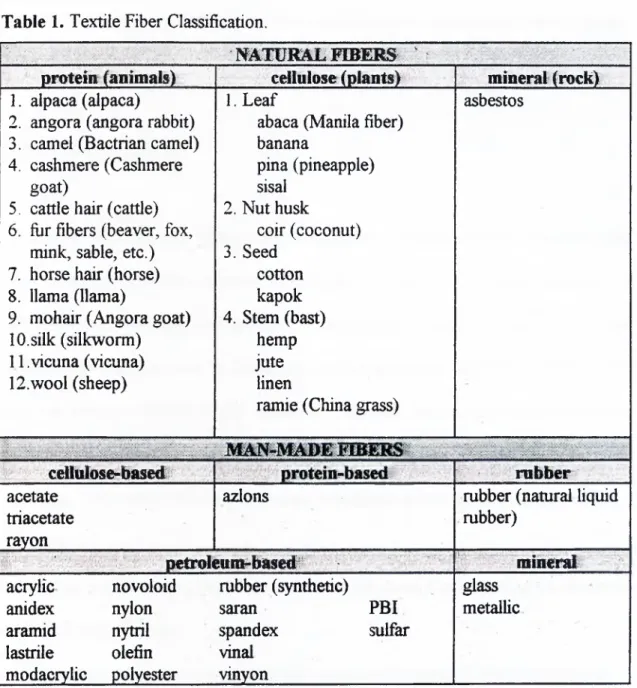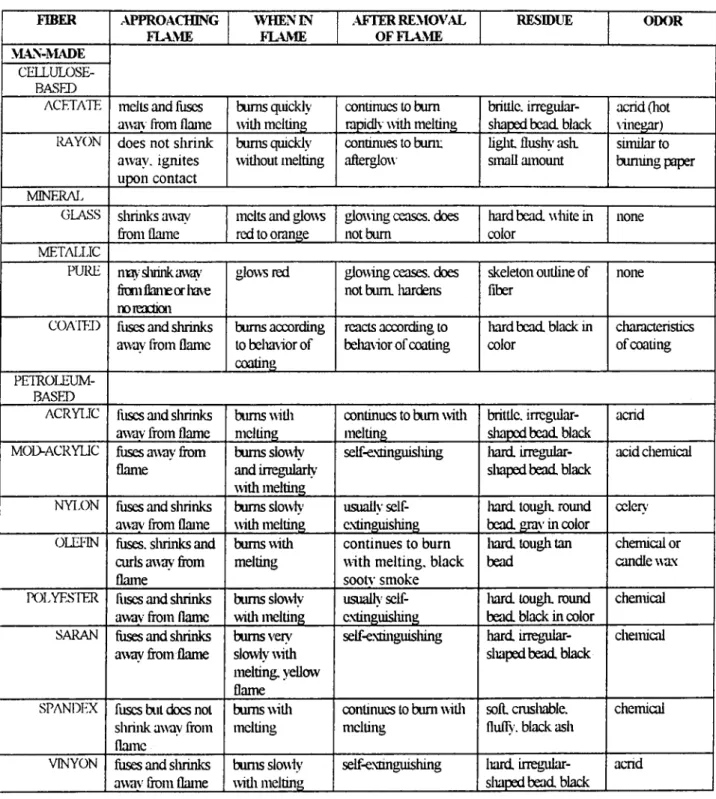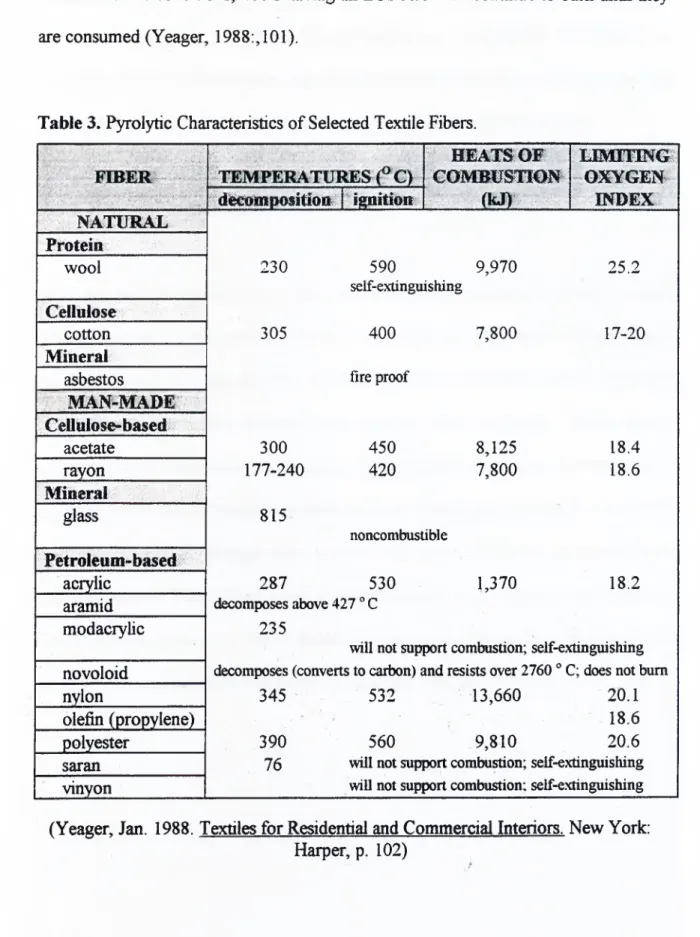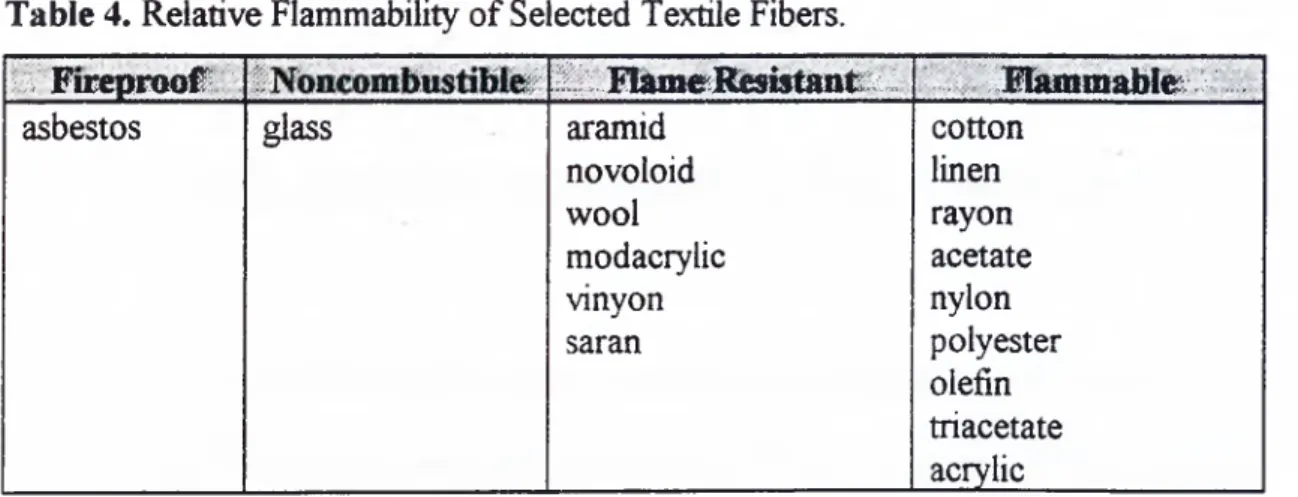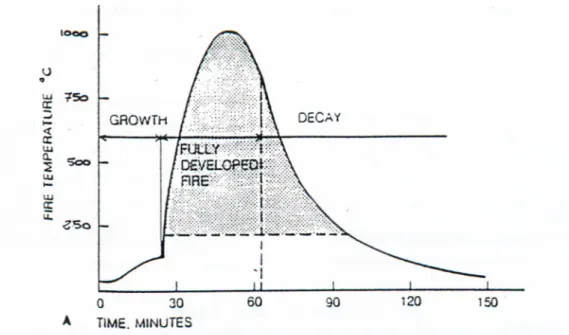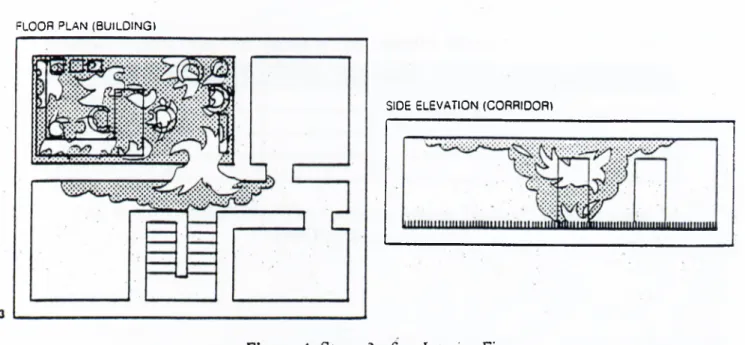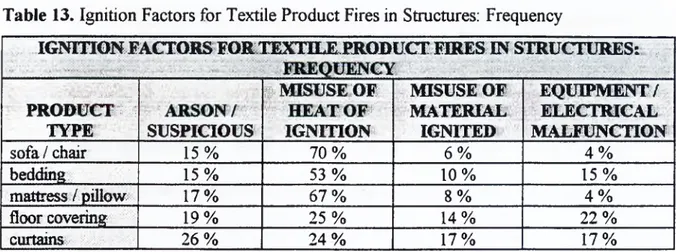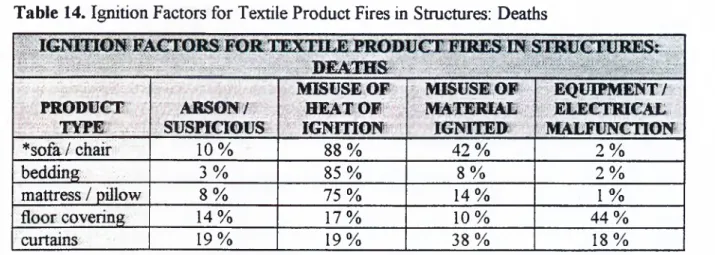ip 8^ ¿p
fí,
:sß ϊί ;Sr^ şf* 'va. Æ i :і« :> · 5 'ifй, S ,κ ni M
M
ti. ·4β^^'Μ.Λ· ííiu а it
й а tüi<iÄ SM» .іі^5г. -i .¿ t:. í·^:^ »:î s :>тя 7«?':«::,?· г. ! í í p ¿ а í » ІХД?'i: :: а iwtí - -J« ;·=? :i г. 51 ϊί W â İ£SS i» ^ » ’w * ж ж, м.· ж. »İ «iΐ ^ ITiplCSy i l l S
'Îİ
m
I
Άi ά' ^
ϋ*i‘Ur í¿· л ^ w ,·
μ
Λ
'■..#*■ î î ?*!“ .*+■* β^·Κ
= i Ій» li^ *!#■
.; ■; *«·-*. :?«9
zfL. t ■*»·*
»■ ■.. ■. M. .«M, . J, , If .-«.»?' Â
·.· ·\» Ьйш
.
« «: -й
- л « ^ V. ..(іГміг.MS-; чі^х __ '
“ ’* ··**·
4-^яі»
: - Jf *«.· ;; Й
И
-Л
«ч1Л
І<' Ж
»
'Ä·.,г** J>^v
'^ ’ · ;·*!» ■•X»' :Т^‘·>:·* t
t '••■^ Г"FIRE SAFETY
OF
INTERIOR TEXTILE FINISHING
A THESIS
SUBMITTED TO THE DEPARTMENT OF
INTERIOR ARCHITECTURE AND ENVIRONMENTAL DESIGN
AND THE INSTITUTE OF FINE ARTS
OF BiLKENT UNIVERSITY
IN PARTIAL FULFILLMENT OF THE REQUIREMENTS
FOR THE DEGREE OF
MASTER OF FINE ARTS
lu/mr·
By
Levent Tiimer
January, 1997
ί 4 4 3
•T4G
■f νό4··Η
I certify that I have read this thesis and that in my opinion it is fully adequate, in scope
and in quality, as a thesis for the degree of Master of Fine Arts.
I certify that I have read this thesis and that in my opinion it is fully adequate, in scope
and in quality, as a thesis for the degree of Master of Fine Arts.
Prof Dr. Mustafa Pultar
I certify that I have read this thesis and that in my opinion it is fully adequate, in scope
and in quality, as a thesis for the degree of Master of Fine Arts.
ABSTRACT
F IR E SA FETY O F IN T E R IO R T E X T IL E FIN ISH IN G
LEVENT TUMER
M.F. A. in Interior Architecture and Environmental Design
Supervisor: Assoc. Prof. Dr. Cengiz Yener
January, 1997
The aim of this thesis is to study the flammability of interior textile finishing and to
explain the important role of Interior Designers in textile specification from the point
of public safety. Use of textile products as interior finishing material, the role of
designers in specification process, textile fiber classification and fire related fiber
properties are defined. Textile flammability, toxicity and the results of textile fires are
also discussed. Turkish, European and International standards on textile flammability
are given. From the point of preventing textile flammability the fire retardant
treatments are defined. Through the all information stated in this thesis, this specific
case is analyzed upon the samples through an experiment and observation. The
results are evaluated through the context of the thesis and further studies are
proposed.
Keywords: Textile, Interior Finishing, Textile Flammability, Standards, Flame-
retardance
Ö Z E T
İÇ M EKA N TA SA R IM U Y G ULA M ALA RIN D A
T E K S T İL Ü R Ü N LER İN İN YANGIN G Ü V E N L İĞ İ
LEVENT TÜMER
İç Mimarlık ve Çevre Tasanmı Bölümü
Yüksek Lisans
Tez Yöneticisi: Assoc. Prof. Dr. Cengiz Yener
Ocak, 1997
Bu tezin amacı, iç mekan tasarım uygulamalannda kullanılan tekstil ürünlerim yangın
güvenliği yönünden incelemek ve İç Mimarların uygulamaya yönelik malzeme
seçimlerinin toplum can güvenliği açısından önemini vurgulamaktır. Bu nedenle
öncelikle tekstil ürünlerinin iç mekanlardaki kullanım alanları, İç Mimarların tekstil
ürünlerinin seçimindeki rolü, tekstil liflerinin sınıflandmlması ve bu liflerin yanıcılık
özellikleri İncelenmektedir. Tekstil yanıcılığı, çıkardığı zehirli gazlar ve bu ürünlerin
sebep olduğu yangınların sonuçları anlatılmaktadır. Tekstil yanıcılığı konusu ile ilgili
Türk standartları, Avrupa standartları ve Uluslararası standartlar ömeklenmektedir.
Tekstil yangınlannın önlenmesi açısından önem taşıyan alev almazlık uygulamaları da
İncelenmektedir. Bu çalışmada geçen tüm bilgiler doğrultusunda tekstil ürünlerinin
yanıcılığı ile ilgili bir arştırma yapılmış olup, bu araştırmanın sonuçlan değerlendirilip
gelecek çalışmalar için önerilerde bulunulmuştur.
A nahtar Sözcükler:
Tekstil, İç Mekanda Bitiş Elemanlan, Tekstil Ürünlerinin
Yanabilirliliği, Alev Almazlık,
A C K N O W L E D G M E N T S
Foremost I would like to thank my supervisor Assoc. Prof. Dr. Cengiz Yener for his
guidance and patience throughout the study and writing of this thesis. Thanks is also
extended to Prof Dr. Mustafa Pultar and Assist. Prof Dr. Zuhal Ulusoy for their
suggestions and for serving on my jury.
I would also thank to all my friends and colleagues for their continuous support.
Special thanks to Giilin, Alp, Timur and Mehmet, for their help and support; and last
but not least thanks go to my family.
Finally, I would like to dedicate this thesis to Seyfi, Neval and Kamuran for the
memories of the good old days.
T A B L E O F C O N T E N T S
A B STR A C T...
iii
Ö Z E T ...
iv
ACKNOW LEDGM ENTS...
v
TABLE OF CO N TEN TS... vi
LIST OF T A B L E S...
ix
LIST OF FIG U R E S...
xi
1. INTRODUCTION...
I
L I. Definition of Textile and F a b ric ... 2
1.2. Use of Textile Products as Interior Finishing M aterials...
3
1.3. Interior Designers’ Role in Textile Specification... 3
1.4. Textile Fibers, Their Classification and Identification... 5
1.4.1. Classification...
5
1.4.2. Identification...
7
1.5. Fire-Related Fibber P ro p erties...
9
1.5.1. Pyrolytic C h aracteristics...
9
1.5.2. Relative Flam m ability...
II
2. FIRE AND THE INTERIOR TEXTILE FINISHING
13
2.1. Textile Flam m ability...
16
2.2. Combustion Processes and B y-products...
17
2.2.1. Combustion Processes...
17
2.2.2. By-products of C om bustion...
18
2.3. Textile Products in F ire s...
19
2.3.1. Sources of Heat of Ignition for Textile F ire s...
22
2.3.2. Ignition Factors for Textile F ire s... 25
2.4. Toxicity of T extiles... 27
2.5. Code Requirements for Interior Textile Finishes...
29
2.5.1. In T u rk ey ... 30
2.5.2. In Foreign C o u n tries... 31
2.6. Standard Test M ethods...
34
3. FLAME RESISTANT TREA TM EN TS... 41
3.1. Classification of Textile Flammability C h aracteristics...
41
3.2. Methods of Treating Textiles for Flam e-R etardance...
42
4. VISUAL OBSERVATION ON FLAMMABILITY OF CARPETS
44
4.1. Purpose of the Visual O bservation...
44
4.2. Objectives of the Visual O bservation...
46
4.2.1. Sam pie Selection...
46
4.2.2. Test P ro ced u re...
53
4.3. Test Results and Discussion...
54
5. C O N C LU SIO N ...
57
6. BIBLIOGRAPHY
60
7. FURTHER READINGS
61
8. APPENDIX - A / T S E STANDARDS
62
9. APPENDIX - B / TSE - CEN - ISO ADDRESSES
165
10. APPENDIX - C / OBSERVATION DATA SHEET
166
11. APPENDIX - D / GLOSSARY
168
12. APPENDIX - E / VIDEO CASSETTE
L IS T O F T A B L E S
Table
1.
Table
2 .Table
3.
Table
4.
Table
5.
Table
6.
Table
7.
Table
8.
Table
9.
Table
10.
Table
11.
Table
12.
Table
13.
Table
14.
Table
15.
Table
16.
Table
17.
Table
18.
Table
19.
Table
20.
Table
21.
Table
22.
Table
23.
Table
24.
Table
25.
Table
26.
Table
27.
Textile Fiber Classification...
6
Reaction of Textile Fibers to Heat and Flame...
8-9
Pyrolytic Characteristics of Selected Textile Fibers...
10
Relative Flammability of Selected Textile Fibers...
12
Type of Fiber First Ignited in Fatal Structure Fires...
16
Materials First Ignited in Structure Fires...
20
Textile Products in Structure Fires; Frequency...
21
Textile Products in Structure Fires. D eaths...
21
Textile Products in Structure Fires; Injuries...
22
Heat Sources for Textile Product Fires in Structures; Frequency...
23
Heat Sources for Textile Product Fires in Structures; Deaths...
24
Heat Sources for Textile Product Fires in Structures; Injunes...
24
Ignition Factors for Textile Product Fires in Structures; Frequency ...
25
Ignition Factors for Textile Product Fires in Structures; Deaths...
26
Ignition Factors for Textile Product Fires in Structures; Injuries...
26
Gases Identified With Combustion of Textile End Products...
28
Turkish Standards on Textile Flammability...
30
Textile Classification...
42
Test Information for Carpet I ...
47
Test Information for Carpet 2 ...
48
Test Intbrmation for Carpet 3 ...
48
Test Information for Carpet 4 ...
49
Test Information for Carpet 5 ...
49
Test Information for Carpet 6 ...
50
Test Information for Carpet 7 ...
50
Test Information for Carpet 8 ...
51
Test Information for Carpet 9 ...
51
Table
28.
Test Information for Carpet 10 ..
Table
29.
Test Information for Carpet 11..
Table
30.
Test Information for Carpet 12 ..
L IS T O F F IG U R E S
Figure
1.
The Stages of a Fire on Time-Temperature C urve...
14
Figure
2.
Stage 1 of an Intenor F ire... ...
14
Figure
3.
Stage 2 of an Interior F ire... ...
15
Figure
4.
Stage 3 of an Interior F ire... ...
15
Figure
5.
Methenamine Pill T est... ... 36
Figure
6.
Steiner Tunnel T est...
37
Figure
7.
Flooring Radiant Panel T est... ...
39
Figure
8.
Flooring Radiant Panel Test Index... ... 39
Figure
9.
Fire Safety C hart...
44
1. IN T R O D U C T IO N
Fire is a serious problem for the humankind through the history and the true nature of
fire is still not clearly understood by most people. In certain periods, statistics are
published on the number of fire deaths and the amount of direct property damage.
However the fire losses are not only limited with deaths or property damage, but other
costs are never shown in to the public interest. For example, lost productive man-
years, lost jobs, business failures, hospital costs, welfare costs and insurance costs are
not published in detail for public information (Whitman, 1979).
From this point of view fire prevention is important for the public safety. It is also
important to know how to prevent a fire. To begin and to survive, a fire needs three
components - heat, oxygen, and a iuel. Those components form the fire triangle. Just
two of the components are not enough and if any one of them is not present, there
will not be a fire. For the same reason, if there is a fire, removing one of the
components will make the fire go out (Derek, 1986, 1). From the point of fire
triangle, textile products that are used in interiors are also act as a fuel. Although it is
impossible to remove textiles from the triangle, it is possible to beware of textile
flammability.
According to the statistics that have been made, intenor textile products play an
important role in the start and/or spread of fires in intenor spaces. This situation
shows the role of textile products and finishes on the public safety from the point of
interior fires. At this point, interior designers have great responsibilities on selecting
furnishings and finishing that are appropriate for fire safety. In order to act
intelligently on this fact, designers have to be aware of the flame resistance, toxicity,
smoke and heat emission properties of various interior textile products. By proper
selections on textile products and finishes, an interior designer can avoid loss of lives
in the event of a fire. Therefore interior designers must have some basic knowledge
on interior textile, finishing flammability and emission properties. That basic
knowledge of the designer will be completed by different sources of information
concerning interior textiles and other finishing, such as professional meetings,
research journals, trade magazines, newspaper articles, information on the materials
that are written by the manufacturer, etc.
A case study, visual observation on flammability of carpets, is conducted about the
verification of all information in the thesis and the analysis of valid situation in
marketplace in Turkey for the sample products.
A basic knowledge on interior textile and finishing flammability must be gained at the
intenor design faculties. From this point of view, this thesis focused on the basic
information about the interior textile products’ flammability in order to act as a guide
for interior designers.
1.1. Defliiition o f Textile an d F ab ric
Fibers, yarns, fibrous and woven fabrics that are manufactured in various ways are
generally named as ‘‘textile” (Yeager, 1988, 14). Many strands of fiber are twisted or
spun together to form a yarn that is made into a textile fabric (Corbman, 1983, 4).
Textiles can be described in various ways from the point of their fiber composition,
interlace structure (weave or knit), surface finish (napped or brushed), chemical finish,
color and porosity characteristics (Schultz, 1985, 366).
1.2. Use o f Textile P ro d u cts as In te rio r Finishing M aterials
Textile products are one of the main elements that are widely used in interior design
applications. Each application requires a different type of textile product according to
its particular need. So the textile product specification for each application varies.
Those application areas can be grouped under 5 main headings from the point of the
required textile product and also from the point of involving in fires as first ignited
material. Those 5 headings are; 1-mattresses and pillows, 2-bedding, 3-upholstered
furniture, 4-curtains and drapes and finally 5-floor covering. Although the application
areas of textile products in interiors are not only limited with those five headings, they
are the main application areas where textile products have a great percentage.
Researchers also focus on these main groups from the fire safety point because textile
products form an important group, after wood and paper, in fire situations if they are
the first ignited item. They cause more injuries and deaths than any other class of
materials that are involved in fires (Tovey and Katz, 1991, 134).
1.3. In te rio r D esigners’ Role in Textile Specification
Fire safety in interior spaces today centers on the flammability of textiles and finishes.
Researches show that the primary elements that supply fuel in the early stages of a fire
are, floor and wall coverings, drapery and furnishings. From this point of view the fire
risk is directly dependent on the textile product selection of an interior designer.
Professional ethic justifies that, a designer should consider the health, safety and
welfare of the public, in spaces that he or she designs (Perez, 1991. 14).
The first five or ten minutes of a fire are the most critical according to the fire safety
experts (ReznikofT, 1979, 33). Fires may grow very quickly; like approximately 5
times in the first minute, 25 times in the second and almost 125 times at the third
minute, depending on many factors. An important one of those factors is the fuel
response that depends on the material’s mass, surface characteristics, etc. As a fact of
fuel response a specified textile product can feed or delay a fire. Therefore, some of
the interior finishes that designers specify may become crucial elements in the early
phase of a fire (Perez, 1991, 15).
Selecting appropriate textile material in interior finishes can prevent or reduce the
beginning of a fire. From this point of view, in case of a fire situation the interior
furnishings and finishing materials must be satisfactory in reacting to the emergency
situation and they must suppress or contain the fire at a certain location. Those textile
materials should have fire resistant fibers and flame resistant treatments in order to
provide the emergency requirements. Although the textile material should meet the
requirements an additional way for suppressing or containing the fire is limiting the
fuel packages that are the combinations of the finishing, furnishings, contents and the
arrangement of them in a space. Lerup, Cronrath and Liu point out that a fuel
package should be defined as any particular amount of fuel in the compartment,
whose operational potential for consumption and spread is either:
a) through a continuity of fuel, or
b) where the discontinuity of material is minimum that the proximity between
materials allows the fire to spread across the discontinuity of surfaces and ignite
adjoining material because of thermal radiation (Cited in Perez, 1991, 16).
In order to apply the fire prevention concept in interior designs a complete knowledge
of fire behavior is required. Although it is hard for a designer to give a priority for
observing or studying fire, he or she must be aware of basic fire safety context in
order to provide a safe design for the public (Perez, 1991, 6).
1.4. Textile Fibers^ T h e ir C lassification an d Identification
Fibers are either produced by nature or manufactured by man. In both situations they
are differentiated by their chemical composition and characterized by specific internal
and external physical features. Because their chemical composition differentiates
textile fibers, they are classified and named on the basis of this composition. Fibers
grouped under the same name are chemically related and tend to exhibit similar
properties (Yeager, 1988, 14).
1.4.1. Classification
Textile fibers are divided into two classification groups, on the basis of how they are
produced, as natural fibers and man-made fibers. From this point of view. Table 1
presents the classification system o f the textile fibers.
Table 1. Textile Fiber Classification.
"·
'
'NATURALFIBERS·
' '
-protein (animals)
cellulose (plants)
mineral (rock)
1. alpaca (alpaca)
2. angora (angora rabbit)
3. camel (Bactrian camel)
4. cashmere (Cashmere
goat)
5. cattle hair (cattle)
6. ilir fibers (beaver, fox,
mink, sable, etc.)
7. horse hair (horse)
8. llama (llama)
9. mohair (Angora goat)
10. silk (silkworm)
11 .vicuna (vicuna)
12.wool (sheep)
1. Leaf
abaca (Manila fiber)
banana
pina (pineapple)
sisal
2. Nut husk
coir (coconut)
3. Seed
cotton
kapok
4. Stem (bast)
hemp
jute
linen
ramie (China grass)
asbestos
cellulose-based
, ,
rubber
acetate
triacetate
rayon
azlons
rubber (natural liquid
rubber)
'
petroleunsi-based
‘
-
mineral
acrylic
novoloid
rubber (synthetic)
anidex
nylon
saran
FBI
aramid
nytril
spandex
sulfar
lastrile
olefin
vinal
modacrylic
polyester
vinyon
glass
metallic
(Yeager, Jan. 1988. Textiles for Residential and Commercial Interiors. New York:
Harper, p. 15)
Although man-made fibers are produced fi’om natural substances, they are not
classified as natural fibers because o f the necessity of industrial processing for
obtaining the end product. After dividing fibers into two main groups another
classification is made, based on the general chemical compositions, like, protein,
cellulose, petroleum-based, or mineral. Finally, fibers are classified with their generic
names. Generic names for natural fibers are the centuries-old common or family
names, and for man-made fibers it is the specific chemical composition name (Yeager,
1988, 14-15).
1.4.2. Identification
For identifying unknown fibers, several tests and examination methods have been
used. Some of the above methods are solubility and staining tests, measurement of
fiber density, microscopic examination, burning tests and visual examination. Those
methods can only be done in laboratory conditions except the burning test. People
who are dealing with the textile fabrics as designers, architects, interior architects,
retailers and consumers can easily make the burning test and get the results by
observing the burned material. The steps mentioned below must be followed for a
burning test:
1. Hold several fibers or a yam from a fabric with metal tweezers over an ashtray to
catch ashes and drips.
2. Strike a match away fix>m the body for safety and to avoid inhaling the smoke and fumes.
3. Observe the reaction of the specimen as it approaches the flame, when it is in the
flame and after the ignition source is removed. Note the odor and examine the
cooled residue.
The reaction data of the fibers are given in the Table 2. At the end of the test, the
observed results may show mixed reaction types; if so then the selected yarn must be
separated to its fibers according to their visual characteristics and then the test must be
repeated (Yeager, 1988, 16).
Table 2. Reaction of Textile Fibers to Heat and Flame.
FIBER
APPROACHING
FX-AiVlE
WHEN IN
FIAME
AFIERREMOV,\L
OF FLAME
RESDDLTE
ODOR
^L4N-^L\DE
CELLULOSE-BASED
ACETATE
mells and fuses
a\va\ from flame
bums quickly
witli melting
continues to bum
rapidly with melting
brittle, irregular-
sliaped bead black
acrid (hot
vinegar)
I^ Y O N
does not shrink
away, ignites
upon contact
bums quickly
witliout melting
continues to bum:
afterglow
hgliLflushyash,
small amount
similar to
bunting paper
MINERAI.
GLASS
shrinks away
from flame
melts and glows
red to orange
glowing ceases, does
not bum
hardhead wliite in
color
none
METALLIC
P U l^
niavslirinkavw
ficni flame or liave
no reaction
glows red
glowing ceases, does
not bum. liardens
skeleton oufline of
fiber
none
COA'IED
fuses and shrinks
away from flame
bums aecording
tobeliaviorof
eoating
reacts according to
beliavior of coating
liard bead black in
color
characteristics
of coating
PETROLEUM-BASED
A C R Y U C
fuses and slirinks
a\vav from flame
bums witli
melting
continues to bum witli
melting
brittle, irregular-
shaped bead black
acrid
M O D -ACR YU C
fuses away from
flame
bums slowly
and irregularh^
with melting
self-extinguisliing
liard inegular-
sliaped bead black
acid chemical
NYIX)N
fuses and shrinks
awav' from flame
bums slowly
with melting
usually self
extinguishing
liaid tough, round
bead gray in color
celery
OLEFIN
fuses, slirinks and
curls awa>' from
flame
bums with
melting
continues to burn
with melting, black
sootv smoke
liard tough tan
bead
chemical or
candle w ax
POLYESTER
fuses and shrinks
away ftom flame
bums slowly
with melting
usualh self-
extinguisliing
liard tough, round
bead black in color
chemical
SARAN
fuses and shrinks
away from flame
bumsveiy
slowly with
melting, yellow
flame
self-exdnguisliing
hard inegular-
sliaped bead black
chemical
S P A N D i^
fuses bul does not
slirink away from
flame
bums witli
melting
continues to bum witli
melting
soft, crusliable.
fluffy. black ash
chemical
VINYON
fuses and slirinks
avvav ftom flame
bums slowly
wltli melting
self-exringuishing
liard inegular-
sliaped bead black
Table 2. (cant’d)
K- ‘ ^ y/·.-‘-'■(■y*
"AV'
... .. .
N A Tim i;;:.
ΡΚσΐΈΙΝ
WOOL
curls away from
flame
bumsslowiy
sdfeKtmguishiiig
brittle, small Hack
bead
similar to
bunting hair or
feathers
SILK
curls aw ^ horn
Oame
bums slowly
and stutters
usually self
extinguishing
bead like, crush^e.
Hade
siniilarto
burning hair or
feathers
CELLULOSE
COTTON
does not shrink
aw^, ignites
upon contact
bums quickly
without melting
oonhnuestobum;
afietglow
light, feathery ash,
light grw to
charcoal in color
similar to
burning ρφετ
LINEN
does not shrink
aw ^, ignites
upon contact
bums quicker
without meltír^
continues to bum;
aflerglow
light, feathery ash,
light gray to
charcoal in color
smilarto
buirting paper
(Yeager, Jan. 1988. Textiles for Residential and Commercial Interiors. New York:
Harper, p. 17-18)
1.5. Fire-Related Fibber Properties
The long and thin physical form of the textile fibers create large amounts o f surface
area when compared with their volume. This large amount of surface area of fibers
increases the ratio o f the atmospheric oxygen absorption needed for combustion
reactions.
Also, their different chemical compositions cause various pyrolytic
characteristics and relative flammability (Yeager, 1988, 101).
1.5.1. Pyrolytic Characteristics
The combustion process is a continuous action which occurs in cycles. During the
combustion the available oxygen decreases in the burning area. Without oxygen and
ignition source some fibers are self-extinguishing. Limiting oxygen index (LOI)
measures the amount of oxygen needed for the combustion process of a fiber. Fibers
with an LOI above 21 self-extinguish after combustion reduces the level o f oxygen
below the normal 21 percent concentration and the source of ignition is removed;
under the same conditions, fibers having an LOI below 21 continue to bum until they
are consumed (Yeager, 1988:,101).
Table 3. Pyrolytic Characteristics of Selected Textile Fibers.
\ / *y K'i
